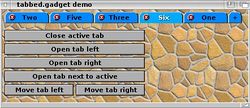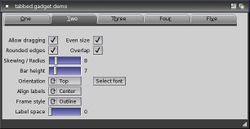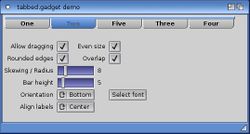Tabbed Gadget Class
Introduction
Tabbed is a Gadget Class used to create a tabbed bar. It is available for both Release V46 and Release V54.
It has some features such as:
- sliding/dragging of tabs by holding down left mouse button over the selected tab and move mouse
- dynamic opening and closing of tabs with an application
- custom tab close gadget
- custom tab fonts and colours
- optional bar which runs underneath tabs
- help pop-up hint tips when hovering mouse pointer over tab
- The active/inactive tab background can be filled with a custom image or gradient
Installation
| Manual installation:
Copy the file tabbed.gadget to SYS:Classes/Gadgets/ directory |
Developer Documentation
| Software Development Kit (SDK):
The include files, examples source code and developer documentation are included in the SDK drawer. |
Datasheet
- NAME
- tabbed.gadget -- Create a tabbed bar
- SUPERCLASS
- gadgetclass
- REQUIRES
- DESCRIPTION
- The tabbed gadget class is used to create a clickable bar with a variable number of tabs (like index cards).
Supported methods
| Method ID | Description |
|---|---|
| OM_NEW | Passed to superclass, defaults set, then OM_SET. |
| OM_SET | Passed to superclass, custom tags set. Calls GM_RENDER if gps_GInfo is supplied. |
| OM_GET | Custom tag returned or passed to superclass. |
| OM_UPDATE | Same as OM_SET |
| OM_NOTIFY | Tag set then passed to superclass. |
| OM_DISPOSE | Free all TabbedNodes and all temporary gfx memory, then passed to superclass. |
| GM_RENDER | Render tab bar. |
| GM_HITTEST | Checks which tab was hit and returns GMR_GADGETHIT if one was hit. |
| GM_GOACTIVE | Re-renders the tab bar with the new active tab highlighted. |
| GM_HANDLEINPUT | Processes input. If the clicked tab was inactive, it acts like a button and becomes active if the mouse button was released over it. If the clicked tab was the active one, it can be dragged left or right. |
| GM_GOINACTIVE | Re-renders the tab bar with the new active tab highlighted. |
| GM_DOMAIN | Returns the required dimensions matching the value in gpd_Which. |
| GM_LAYOUT | calculates the size and position of each tab relative to the total space given. |
| TGM_ADDTAB | Inserts a new tab with the given labal and flags at the given position. Returns a pointer to the TabbedNode of the new tab or NULL in case of failure. Calls GM_RENDER if tgp_GInfo is supplied. |
| TGM_REMTAB | Removes the tab at the given position and frees the TabbedNode.Calls GM_RENDER if tgp_GInfo is supplied. |
| TGM_MOVETAB | Moves the tab at the given position to the new position. Calls GM_RENDER if tgp_GInfo is supplied. |
| TGM_ADDNODE | Inserts a new tab before the given successor TabbedNode. If tgp_Succ is NULL the new tab is added to the end of the list. Returns a pointer to the TabbedNode of the new tab or NULL in case of failure. Calls GM_RENDER if tgp_GInfo is supplied. |
| TGM_REMNODE | Removes the given TabbedNode and frees its memory.Calls GM_RENDER if tgp_GInfo is supplied. |
| TGM_MOVENODE | Removes the given TabbedNode and inserts it back before the new successor. Calls GM_RENDER if tgp_GInfo is supplied. |
ATTRIBUTES
- GA_BackFill (struct Hook *)
- REACTION_BackFill
- GM_RENDER installs the given backfill hook before doing it's rendering
- Applicability is (OM_NEW, OM_SET, OM_UPDATE)
- TABBED_Labels (STRPTR *)
- A NULL-terminated array of string pointers. Replaces all tabs.
- The previous tab list is freed. Each string in the array gives
- a new tab. The tbn_ID field of each tab is initialized with a
- sequential number starting at 0 for the first tab.
- Applicability is (OM_NEW, OM_SET, OM_UPDATE)
- TABBED_Active (ULONG)
- Sets or returns the place number of the currently active tab.
- -1 means no tab is active. Defaults to -1.
- Applicability is (OM_NEW, OM_SET, OM_GET, OM_UPDATE, OM_NOTIFY)
- TABBED_ActiveNode (struct TabbedNode *)
- Sets or returns a pointer to the TabbedNode of the currently
- active tab. Defaults to NULL.
- Applicability is (OM_NEW, OM_SET, OM_GET, OM_UPDATE, OM_NOTIFY)
- TABBED_ActiveID (ULONG)
- When a new tab becomes active, the ICA_TARGET is notifed with
- this tag. Contains the tbn_ID of the active TabbedNode or -1
- if no tab is active. Defaults to -1.
- Applicability is (OM_NOTIFY)
- TABBED_Skew (ULONG)
- Sets or returns the level of skewing. For rounded corners it
- defines the radius of the rounding. Defaults to 8.
- Applicability is (OM_NEW, OM_SET, OM_GET, OM_UPDATE)
- TABBED_Rounded (BOOL)
- Selects whether the tabs have rounded corners (TRUE) or are
- skewed squares (FALSE). Defaults to FALSE.
- Applicability is (OM_NEW, OM_SET, OM_GET, OM_UPDATE)
- TABBED_Font (struct TextFont *)
- Sets the font used by tab labels. Defaults to the screen font.
- Applicability is (OM_NEW, OM_SET, OM_GET, OM_UPDATE)
- TABBED_MinWidth (ULONG)
- Minimum width of each tab. Useful when using TBNF_NameIsHook
- because the hook does not have a width or if the labels are
- very short. Defaults to 0.
- Applicability is (OM_NEW, OM_SET, OM_GET, OM_UPDATE)
- TABBED_AllowDragging (BOOL)
- Selects whether tabs can be reordered by dragging the active tab
- with the mouse (TRUE) or not (FALSE). Defaults to FALSE.
- Applicability is (OM_NEW, OM_SET, OM_GET, OM_UPDATE)
- TABBED_FirstNode (struct TabbedNode *)
- Returns a pointer to the TabbedNode of the first tab in the list.
- Returns NULL if there are no tabs.
- Applicability is (OM_GET)
- TABBED_LastNode (struct TabbedNode *)
- Returns a pointer to the TabbedNode of the last tab in the list.
- Returns NULL if there are no tabs.
- Applicability is (OM_GET)
- TABBED_TabMovedFrom (ULONG)
- TABBED_TabMovedTo (ULONG)
- If the user has dragged a tab to a new position, the ICA_TARGET
- is notified with these tags.
- Note that only the active tab can be dragged. So if you receive
- an update with these tags, you can get the TABBED_ActiveNode
- attribute to find out details about the dragged node.
- Applicability is (OM_NOTIFY)
- TABBED_SmallWidth (ULONG)
- Like TABBED_MinWidth, but for tabs with TBNF_SmallTab set.
- Applicability is (OM_NEW, OM_SET, OM_GET, OM_UPDATE)
- TABBED_Pens (UWORD *)
- Points to an array of pen numbers. The entries match those in
- the dri_Pens field of struct DrawInfo (see intuition/screens.h).
- The array does not need to be terminated, but it must contain
- all these entries:
- SHINEPEN -> bright edges of the border surrounding each tab
- SHADOWPEN -> dark edges and shadow of the active tab's label
- HIGHLIGHTTEXTPEN -> label of the active tab
- FILLTEXTPEN -> label of a tab when the user clicks on it
- TEXTPEN -> label of all other tabs
- DETAILPEN -> background of the active tab
- FILLPEN -> background of a tab when the user clicks on it
- BACKGROUNDPEN -> background of all other tabs
- HIGHLIGHTTEXTPEN is the highest index which means the array must
- contain at least 9 entries.
- If set to NULL the pens from the screen the GUI runs on are used.
- Defaults to NULL.
- Applicability is (OM_NEW, OM_SET, OM_GET, OM_UPDATE)
- TABBED_CloseImage (struct Image *)
- Sets the image used for nodes with the TBNF_HasCloseButton flag
- set. A BOOPSI image is preferred. If not set it defaults to a
- small round button with a cross in it.
- Applicability is (OM_NEW, OM_SET, OM_GET, OM_UPDATE)
- TABBED_CloseImagePens (UWORD *)
- This tag is forwarded to the TABBED_CloseImage object as IA_Pens.
- Points to an array of pen numbers. The entries match those in
- the dri_Pens field of struct DrawInfo (see intuition/screens.h).
- For the default close button image the array does not need to be
- terminated, but it must contain all these entries:
- FILLPEN -> the area inside the button
- SHINEPEN -> the bright edges of the outer border and
- the inner of the cross if not selected
- SHADOWPEN -> the dark edges of the outer border and
- the outer of the cross
- BACKGROUNDPEN -> the inner of the cross when selected
- BACKGROUNDPEN is the highest index which means the array must
- contain at least 8 entries.
- If set to NULL the pens from the screen the GUI runs on are used.
- Defaults to NULL.
- Applicability is (OM_NEW, OM_SET, OM_GET, OM_UPDATE)
- TABBED_ClosedTab (ULONG)
- TABBED_ClosedNode (struct TabbedNode *)
- TABBED_ClosedID (ULONG)
- When the close button of a tab was clicked by the user, the
- ICA_TARGET will be notified about these tags.
- TABBED_ClosedTab is the place in the list of the clicked tab.
- TABBED_ClosedNode is the TabbedNode of the clicked tab.
- TABBED_ClosedID is the tbn_ID of the clicked tab.
- Applicability is (OM_GET, OM_NOTIFY)
- TABBED_ClickedTab (ULONG)
- TABBED_ClickedNode (struct TabbedNode *)
- TABBED_ClickedID (ULONG)
- When a tab with the TBNF_DontActivate flag set was clicked by the
- user, the ICA_TARGET will be notified about these tags.
- TABBED_ClickedTab is the place in the list of the clicked tab.
- TABBED_ClickedNode is the TabbedNode of the clicked tab.
- TABBED_ClickedID is the tbn_ID of the clicked tab.
- Applicability is (OM_GET, OM_NOTIFY)
- TABBED_BarHeight (ULONG)
- Determines the height of a bar which is drawn below the row of
- tabs in the color of the active tab. If set to 0, no bar is drawn.
- Defaults to 0.
- Applicability is (OM_NEW, OM_SET, OM_GET, OM_UPDATE)
- TABBED_GadgetHelpCode (ULONG)
- Specifies what tabbed.gadget should return from a GM_HELPTEST
- method call. Currently the following values are supported:
- 0 - returns the place of the tab the mouse is over.
- 1 - returns the tbn_ID of the tab the mouse is over.
- Any other value will cause it to return GMR_HELPHIT.
- Applicability is (OM_NEW, OM_SET, OM_GET, OM_UPDATE)
- TABBED_HintInfoHook (struct Hook *)
- This hook is called by the GM_QUERY method if the mouse hovers
- over a tab. Defaults to NULL.
- result = info_hook (hook, tab, msg);
- D0 A0 A2 A1
- CONST_STRPTR result -> hint text to be displayed
- struct Hook *hook;
- struct TabbedNode *tab;
- struct qpQuery *msg;
- Applicability is (OM_NEW, OM_SET, OM_GET, OM_UPDATE)
- TABBED_TabBackFill (struct Hook *)
- Backfill hook for normal (not active) tabs.
- Set this to TABBED_BACKFILL_GRADIENT to get a gradient in the
- background. Gradients are only drawn on truecolor RTG screens
- (16 bits or more).
- Applicability is (OM_NEW, OM_SET, OM_GET, OM_UPDATE)
- TABBED_ActiveBackFill (struct Hook *)
- Backfill hook for the active tab.
- Set this to TABBED_BACKFILL_GRADIENT to get a gradient in the
- background. Gradients are only drawn on truecolor RTG screens
- (16 bits or more).
- Applicability is (OM_NEW, OM_SET, OM_GET, OM_UPDATE)
- TABBED_AlignLabel (LONG)
- Define the alignment of standard labels in tabs. Valid values are:
- -1 left justified
- 0 centered
- 1 right justified
- Defaults to 0.
- Applicability is (OM_NEW, OM_SET, OM_GET, OM_UPDATE)
- TABBED_Orientation (ULONG)
- Defines whether the tab gadget should appear as if it is above or below the pages it controls.
- Valid values are:
- TABBED_ORIENTATION_TOP - the tabs are above the pages
- TABBED_ORIENTATION_BOTTOM - the tabs are below the pages
- Defaults to TABBED_ORIENTATION_TOP.
- Applicability is (OM_NEW, OM_SET, OM_GET, OM_UPDATE)
- TABBED_DontOverlap (BOOL)
- Do not allow the tabs to overlap each other. This will shrink the
- tabs so that they all fit next to each other. It might cause
- graphical glitches if the tabs become too small to display
- properly. Defaults to FALSE.
- Applicability is (OM_NEW, OM_SET, OM_GET, OM_UPDATE)
- tabbed_gc/--background--
- BACKGROUND
- Initially tabbed class only supported setting the list of tabs through
- the TABBED_Labels attribute. This has kind of static character. Although
- you could set it to a new value at any time, it would always replace the
- whole list of tabs. And tabs could only have textual labels.
- Internally it always worked with a linked list of TabbedNode structures,
- therefore new methods were introduced which allow basic access to the internal TabbedNodes.
- While TGM_ADDTAB, TGM_REMTAB and TGM_MOVETAB still work with place numbers,
- TGM_ADDNODE, TGM_REMNODE and TGM_MOVENODE allow to use node pointers.
- Still you have to use TGM_ADDTAB or TGM_ADDNODE to create a new tab. You
- must not allocate your own TabbedNode and insert it into the list!
- The ln_Name field holds a pointer to the label. Depending on tbn_Flags
- this pointer can be interpreted in different ways:
- TBNF_NameIsLabel -> ln_Name points to a string
- TBNF_NameIsIntuiText -> ln_Name points to a struct IntuiText
- TBNF_NameIsImage -> ln_Name points to a struct Image or to a BOOPSI image object
- TBNF_NameIsHook -> ln_Name points to a struct Hook. This is very similar to GTLV_CallBack in GadTools.
- There is one flag which is only relevant when the tab is added by
- TGM_ADDTAB or TGM_ADDNODE:
- TBNF_Activate -> if this flag is set, the new tab will become the active one.
- These flags are for advanced functions:
- TBNF_HasCloseButton -> this flag adds a close button to the tab. The
- image used can be set by the TABBED_CloseImage
- tag. The size of the close button adds to the
- minimum width of the tab.
- When the user clicks the close button, there
- will be no action except that the application
- is notified about the TABBED_ClosedTab,
- TABBED_ClosedNode and TABBED_ClosedID tags.
- TBNF_SmallTab -> if this flag is set, the tab will stay at its
- minimum width and won't be resized like regular tabs.
- You can define a minimum width for all tabs
- with the TBNF_SmallTab flag set using the
- TABBED_SmallWidth tag.
- TBNF_DontActivate -> if this flag is set, the tab won't become the
- active tab when the user clicks on it. The
- application will be notified via the
- TABBED_ClickedTab, TABBED_ClickedNode and
- TABBED_ClickedID tags.
- TBNF_StopDrag -> if this flag is set, the user cannot drag other
- tabs beyond this one. It is especially useful
- if the tab shall stay at the end or at the
- beginning of the list. But it can also be used
- to seperate groups of tabs.
- SEE ALSO
- gadgets/tabbed.h
- tabbed_gc/TABBED_GetClass
- NAME
- TABBED_GetClass -- Gets the pointer to the tabbed class (deprecated).
- SYNOPSIS
- tabbed_class = TABBED_GetClass();
- D0
- Class * TABBED_GetClass(VOID);
- FUNCTION
- For compatibility with ClassAct and ReAction on OS 3 the class
- library contains this function at offset -30 which returns the
- class pointer.
- The preferred method to obtain the class pointer is to read it
- from the cl_Class field of the library base.
- INPUTS
- Nothing.
- RESULT
- tabbed_class - Pointer to the Tabbed gadget class.
- SEE ALSO





